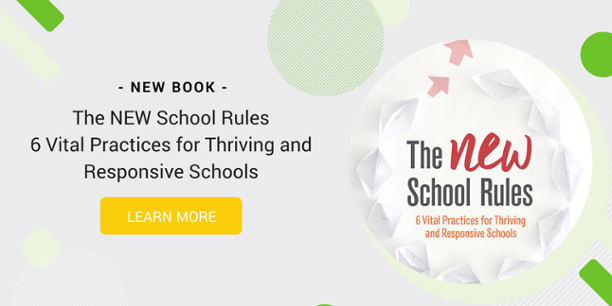Personalization is everywhere you turn today - from your online shopping recommendations to your daily coffee order. Some districts have realized the power of personalization and begun to tailor the way they interact with families and students. But the power of personalization for family and student engagement is just beginning to be tapped and requires more than a customized parent portal or individualized lesson plan to truly engage diverse families and students. And in our current state of national affairs, finding ways to deeply connect with students and families is more important than ever.
To achieve meaningful student and family engagement, we believe we must disrupt implicit bias by shifting the structure of our schools and districts toward a more personalized approach. Emerging research suggests that a focus on individual needs and beliefs has the potential to disrupt bias at all levels of a system. We see personalization as dynamically tailoring any service or product to the wants and needs of each user and believe that personalized classroom design and family engagement are both key drivers to break down implicit and explicit biases in classrooms and schools. We believe that the end goal of personalization should not be simply changing family communication or offering student choice, but rebuilding districts to be more inclusive, open systems.
In this post we define implicit bias, share how implicit bias can affect your school or district, and offer steps you can take to disrupt implicit bias by personalizing your system for students and families.
What is implicit bias?
Implicit bias, as defined by The Kirwin Institute, “refers to the attitudes or stereotypes that affect our understanding, actions, and decisions in an unconscious manner.” Implicit biases are associations we make without even knowing we are doing it. These associations “cause us to have feelings and attitudes about other people based on characteristics such as race, ethnicity, age, and appearance.”
Humans have developed implicit biases as cognitive shortcuts for survival. As The Perception Institute explains, “most of our actions occur without our conscious thoughts, allowing us to function in our extraordinarily complex world.” We focus on salient features of others (gender, race, ethnicity, age, height, etc) to help us quickly categorize others into manageable groups. As Teaching Tolerance has shared “While the brain isn’t wired to be racist, it uses biases as unconscious defensive shortcuts. As human beings, we are not naturally racist. But because of the way our brains are wired, we are naturally ‘groupist.’.” These implicit biases affect the way we interact with others. And while implicit biases are different from explicit or structural biases, the three are often mutually reinforcing.
How does implicit bias affect my school or district?
If we acknowledge that we are all wired to be “groupist” the next question we must ask is, what is the implication of this wiring on our schools, districts, and communities? Teaching Tolerance offers, “This wiring for ‘groupism’ usually leads the dominant culture (the in-group) in a race-based society to create ‘out-groups’ based on race, gender, language, and sexual orientation. Large systems such as school districts, which are often led and largely staffed by members of the dominant (“white”) culture can often magnify and amplify the implicit biases toward ‘out-groups.’”
The result on students and families is dramatic as interactions with school and district staff can trigger fear centers that react quickly to threats or “microagressions.” Teaching Tolerance explains, “The brain has developed the ability to actually sniff out threats. It’s called neuroception and happens when the brain’s neural circuits send information to the brain’s fear center to determine if new situations or people are safe or dangerous. Like a watchdog, the amygdala in the fear center is designed to react in less than a second, at the very hint of a social threat,”
Interactions between teachers, principals, and district leaders with students and families during school days, family nights, or parent-teacher conferences can trigger neuroception. Implicit biases can lead to a force field that can isolate individuals and communities and prevent deep engagement between students and teachers, families and schools. Personalization provides an opportunity to disrupt implicit bias and offers a path forward to increased awareness and systems-level change. We believe personalized interactions with students and families promote deeper relationships that can start to disrupt implicit biases and “groupisms”.

How can I disrupt implicit bias in my school or district?
So how can we begin to disrupt bias in our schools and districts? As we mentioned earlier, research shows that bias can be reduced by individuation (seeing individuals apart from a group), gaining new perspectives from stereotyped groups, and increasing opportunities for contact with “out-group” members. We believe personalizing your school and district systems can achieve these goals and have developed four focus areas for doing so. Each focus area includes specific steps you can take to personalize your system for students and families.
- Build empathy. A critical step for starting to rewire our implicit biases is immersing ourselves in opportunities to connect with people and perspectives outside our “comfort zone.” How can we better understand the needs, interests, and passions of our students and families?
- Students: Support teachers to engage in parent-teacher home visits as a way to learn about the hopes and dreams of students and their families and to build a relationship beyond the physical school building.
- Families: Create opportunities to hear from families about what matters most to them. Find ways to move conversations with families out of the school building and into the community and think about how you can create a safe space in these conversations to talk about power, race, and community.
- Focus on individuals versus groups. Research shows that individuation is the main channel to disrupt implicit bias and build relationships and trust. It can be difficult for schools and district to think beyond “groupisms” because we are often dealing with large quantities of people-- hundreds or thousands of students and families. The magnitude of our scale makes individual conversations and relationships even more important and powerful.
- Students: Build ways for teachers and principals to learn about the specific interests, needs, passions, and cultural contexts of individual students. Some schools use learner profiles to help facilitate this learning process.
- Families: Meet 1-1 with parents and families to get feedback on school and district decisions. These 1-1 meetings can help you understand the “family” perspective as one that is actually nuanced, varied, and unique across the many families in your school system.
- Shift from static to dynamic. At its heart personalization is dynamically tailoring any service or product to the wants and needs of each user. How can we build our school and district to be more responsive and dynamic to individual needs? Which legacy systems can we leave behind?
- Students: Think about the instructional models that are being used in your classrooms. How can you create flexible classroom designs? How can you select instructional models and curricular tools that meet the needs of individual students versus the class “average”? How can you build lessons and instructional models that are culturally responsive to your students?
- Families: Build systems that support families to co-create with your school or district in an ongoing manner. Think beyond a single feedback session and design processes where you can truly share power with your community through structures like Parent Teacher Leadership Teams.
- Open your systems. We think a critical step to disrupting implicit bias is to also disrupt systemic bias, by shifting the power from a few individuals to broader groups within our schools, districts, and communities. We like to think of this as making a shift from a closed (hierarchical) structure to an open (responsive) structure.
- Students: Include student voice in decision-making. Designing a lesson? Determining the lunch menu? Making a hiring decision? Involve students in designing the process. Check out these toolkits for student-driven design.
- Families: Read The Open System blog post and reflect on how you might start to disrupt closed systems in your district.
We believe these focus areas provide some first steps that any school or district can take. Though some steps can be intimidating at first, we believe personalization is achievable by all districts. And through personalization your school system can become a more welcoming, inclusive environments for all students and families.
If you’re interested in learning more about how bias, race, and equity we’ve also compiled this short resource list.
- Courageous Conversations about Race
- Project Implicit: Harvard University
- Racism and Inequity Are Products of Design. They Can Be Redesigned
- How Racial Bias Affects The Quality of Black Students’ Education
You can also sign up to learn more about the launch ofThe NEW School Rules, which introduces principles and practices that provide the framework for transitioning rigid, slow-moving institutions into environments of continuous innovation.
This blog post was originally published on AASA.




